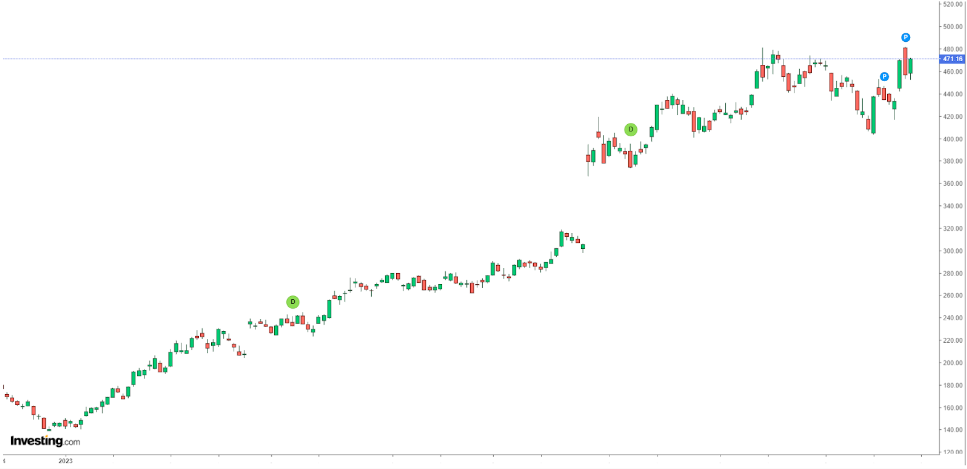- Nvidia's Q2 results exceeded expectations in every respect
- Profitability soared along with revenues
- The world leader in graphics processors essential to AI also announced highly optimistic future prospects
Nvidia's (NASDAQ:NVDA) latest quarterly earnings, unveiled last night, were nothing short of a thrilling surprise, exceeding already high expectations by a significant margin.
The driving force behind this exceptional performance? The surging demand for AI across every facet of our economy.
Anticipating an earnings per share (EPS) of $2.09, a figure that was already nearly double the Q1 EPS, industry pundits were caught off guard when the actual number soared to $2.70, surpassing their predictions by a staggering 30%.
But the excitement doesn't end there. Nvidia's revenue skyrocketed to a jaw-dropping $13.51 billion, nearly doubling the previous quarter's $7.19 billion and leaving analysts in awe with a more than 20% overachievement compared to their forecasts.
Given this positive surprise, Nvidia's stock, which had already risen over 3% during regular trading, surged over 6.5% in after-hours trading. This surge is likely to continue during today's trading session.
At this point, Nvidia's stock has gained over 222% since the beginning of the year, making it by far the best-performing tech stock in an overall positive 2023.
Profitability Soars Along With Revenues
Going into more detail, the announced Q2 revenue of $13.51 billion corresponds to a yearly growth of 101%. However, in addition to this remarkable revenue growth, Nvidia managed to significantly boost its profitability.
In fact, the company's gross margin increased by over 25 percentage points compared to the same quarter of the previous year, reaching 71.2% – an unprecedented level for a physical product.
Consequently, net income came in at $6.7 billion, a staggering +420% increase year-over-year.
By segment, Nvidia reported revenues of $10.3 billion from data centers, a 170% annual increase, and $2.5 billion from gaming, surpassing forecasts of $8 billion and $2.4 billion, respectively.
Strong Forecasts and Share Buybacks Could Keep Nvidia’s Positive Momentum Going
Nvidia also did not disappoint in terms of forecasts, anticipating revenue of $16 billion for the third quarter, with a margin of error of 2%. This is much higher than the $12.5 billion predicted by analysts.
This would represent growth of over 18% quarter-over-quarter and almost 170% compared to the same quarter of the previous year. Moreover, it's worth noting that Nvidia has exceeded revenue expectations for the past 8 consecutive quarters, according to InvestingPro data.
Furthermore, Nvidia CEO Jensen Huang expressed strong confidence, stating that the company has excellent visibility for the current year and the next while also preparing for the next generation of infrastructure with leading cloud computing companies and data center manufacturers.
In an interview with Reuters, Huang mentioned that two factors were driving this demand: the shift from traditional data centers built around central processors to those built around Nvidia's powerful chips and the growing use of AI-generated content across various fields, from legal contracts to marketing documents.
"These two fundamental trends are at the root of everything we're observing, and we're only about a quarter of the way through," he said. "It's hard to say how many quarters are ahead, but this fundamental shift isn't stopping anytime soon. This is not a one-quarter event."
This confidence in the future, along with the company's strong financials, allowed it to offer an extra gift to shareholders – announcing a new $25 billion share buyback plan. A portion of these buybacks will be executed in the current fiscal year, adding to the already exciting announcement.
Chinese Demand and AMD Competition: Underestimated Risks?
It's worth noting, however, that some analysts have expressed concerns that a significant portion of Nvidia's Q2 demand surge came from China, where companies are stockpiling chips due to concerns over potential future US export restrictions. This source of growth could dwindle at any moment.
Furthermore, investors seem to underestimate AMD's potential, a direct competitor of Nvidia. This is especially true given the current market situation, where demand exceeds supply.
"AMD chips could be up to 50% cheaper than Nvidia GPUs, and companies like Meta) or Google might want to reduce their costs."
He also pointed out that "historically, in the semiconductor field, the leader always holds 70 or 80% of the market share, but customers still want a second source of supply so that the leader doesn't charge excessively high prices. In this case, that second source is AMD."
"Given that the semiconductor industry is projected to hit $1 trillion by 2030, we're talking about a very interesting valuation for Nvidia if it manages to hold on to its market leadership for the next few years," added Thomas Monteiro, a Senior Analyst at Investing.com last night.
"Despite the current 240+ PE, this report indicates that the company is on the right track to significantly outperform the competition and, thus, consistently lower that ratio," concluded Monteiro.
Conclusion
Nvidia's financial results released on Wednesday were not only a milestone for the company, but also a crucial test for market enthusiasm towards AI-related investments.
These results may fuel investors' appetite for all AI-related investments, as they justify the continuation of the stock's rise.
However, it should be acknowledged that Nvidia is currently one of the few companies already benefiting from AI in its results, while others are mainly investing to better integrate AI into their operations.
***
Disclaimer: This article is written for informational purposes only; it does not constitute a solicitation, offer, advice, or recommendation to invest as such it is not intended to incentivize the purchase of assets in any way. I would like to remind you that any type of asset, is evaluated from multiple points of view and is highly risky and therefore, any investment decision and the associated risk remains with the investor.

